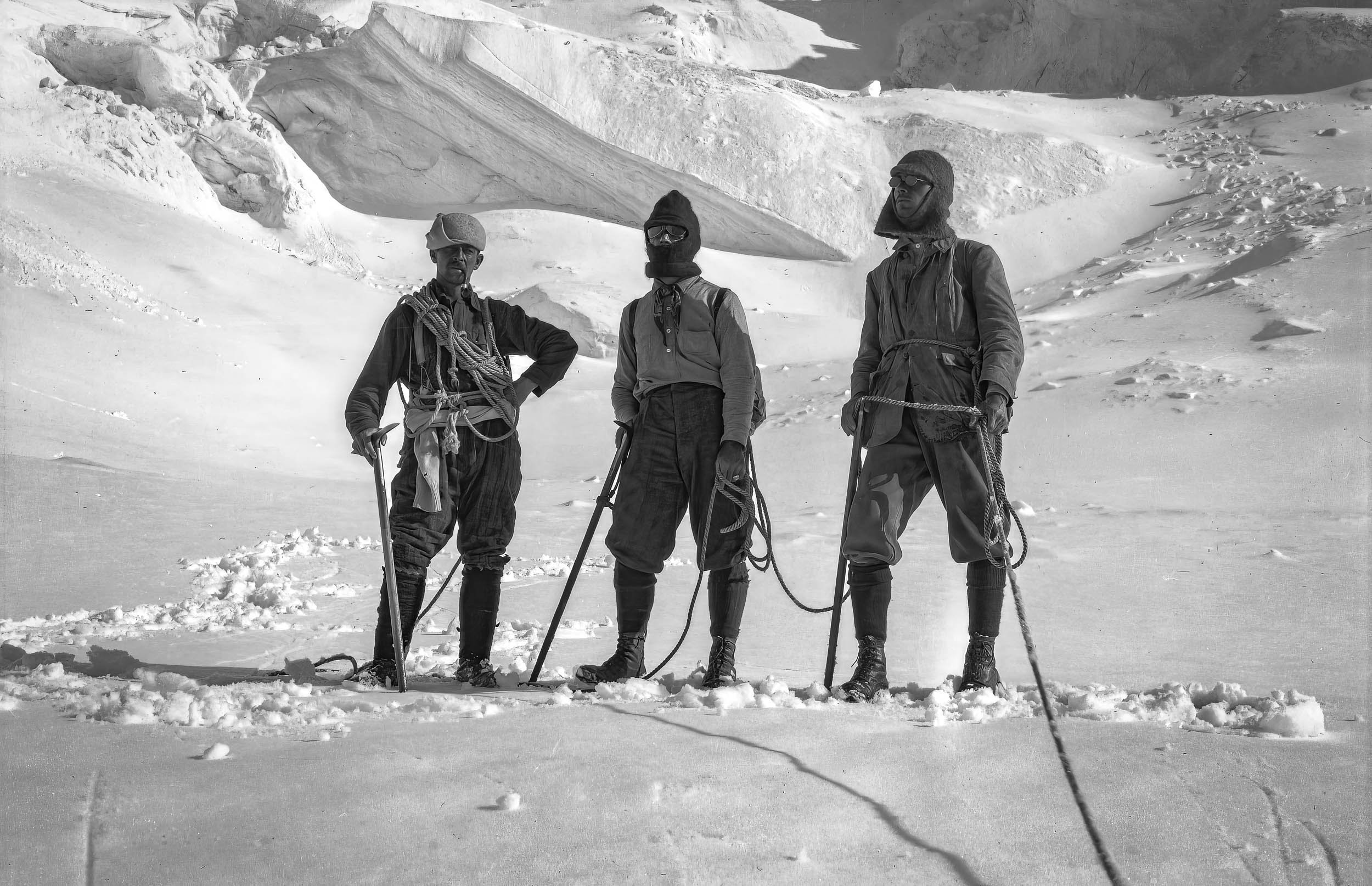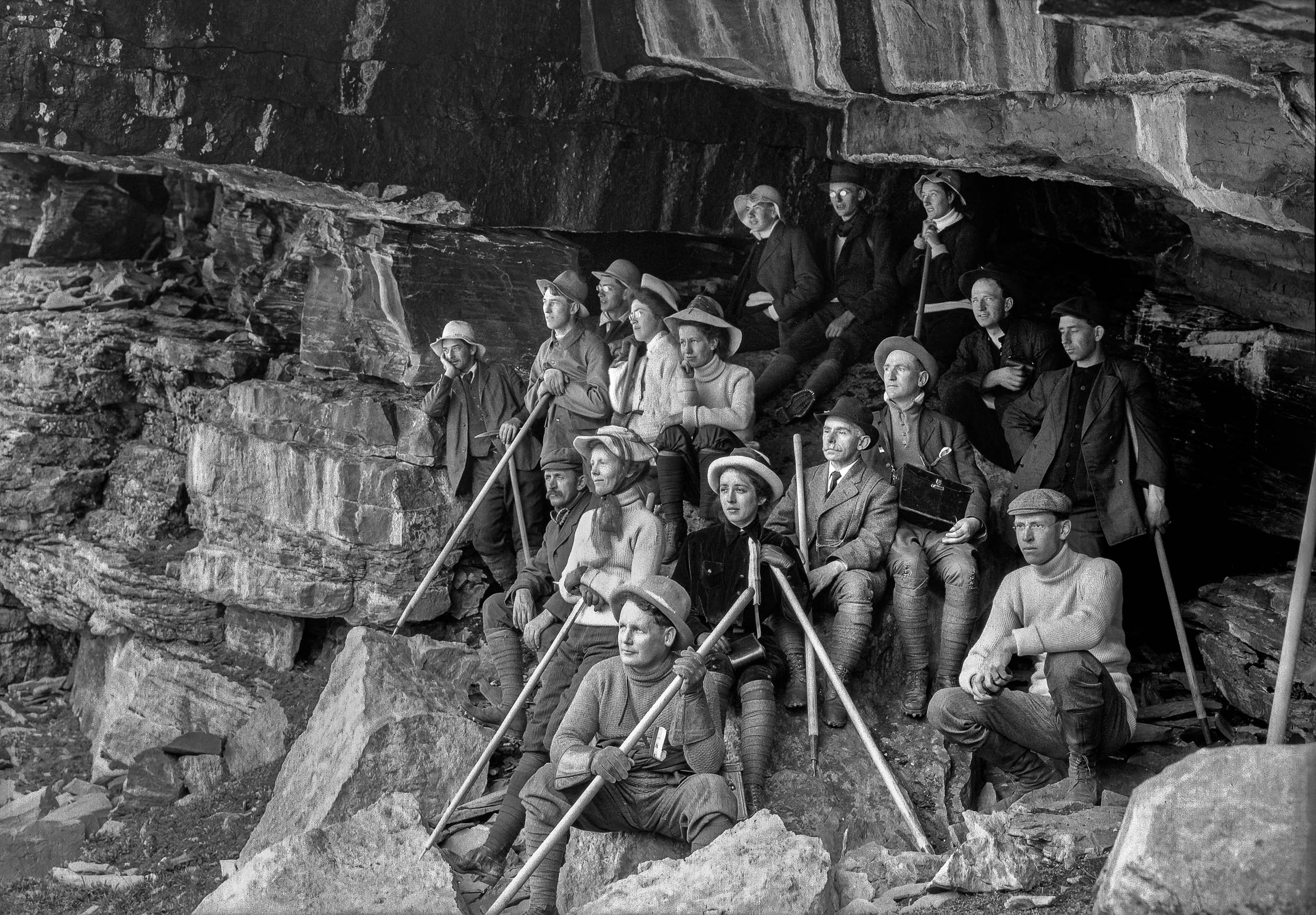His Legend
Conrad Kain, Albert H. MacCarthy and Basil S. Darling, Robson-ACC Camp, 1913. Byron Harmon photo
CONRAD BROUGHT GLAMOUR AND IMAGINATION into the sport of mountaineering as few guides have done before him.
His approach to mountains was first and foremost an esthetic one; he saw a peak first as something beautiful—the technical problem was always secondary—and nothing counted beside that vision.
— J. Monroe Thorington
Conrad Kain served as a guide for nearly 30 years in Europe, Canada and New Zealand, and during that relatively short period, he left a unique and unequalled legacy of mountain exploration and first ascents. In moving through extreme landscape, he displayed a creativity that stands alone in the annals of Canadian mountaineering. Yet, he lived a simple, independent life and always saw himself as a man of nature.
Climber/historian Zac Robinson paints a picture of his hero: “Accounts of Kain reveal a thoroughly personable and professional guide. Standing five feet five inches, he had a stocky build with broad shoulders; his moustache and pipe were constant features. In camp and on the trail, he could be charming, harmlessly flirtatious, and an entertaining storyteller. An expert axe man and cook with a great capacity for carrying weight, he was patient with novices and discreet in his treatment of over-zealous climbers disinclined to appreciate natural splendours.”
Today, he is remembered primarily for three first ascents in western Canada—Mount Robson (1913), Mount Louis (1916) and Bugaboo Spire (1916). These three climbs were extraordinary achievements, particularly considering the basic climbing equipment of his day and that they were performed while guiding amateur mountaineers. Yet, his mountaineering successes extend far beyond these three climbs.
Kain is credited with more than 60 first ascents and new routes in the Canadian Rockies and British Columbia's Purcell Range. Indeed, he can be regarded as the pioneer alpinist of the Purcells, where he guided clients to the summits of most of the range's highest mountains; within the Bugaboo group, which contains some of North America's most technical peaks, he made five first ascents. Additionally, he travelled to New Zealand three times between 1913 and 1916, where he guided more than 25 first ascents and climbed the country’s highest summit, Mount Cook, twice.
As much as he may have embraced the beauty and challenge of an unclimbed peak, Kain was just as attached to the life he discovered in the wilderness of western Canada. Following his arrival in Canada in 1909, he accompanied several important explorations, including the first surveys of the Bugaboos in 1910, the Mount Robson region in 1911, and sections of the Alberta-B.C. boundary in 1913, 1914 and 1919. He learned much about life in the wilds on these trips and subsequently satisfied his independent spirit by earning part of his living as a trapper, hunting guide and an outfitter.
Following his death in 1934, his friend and climbing companion J. Monroe Thorington published his autobiography. In reality it was a compendium—a collection of bits and pieces written by Kain, clients and friends, including Thorington himself—that created a wonderful portrait of a life of exceptional achievement and adventure. For anyone who would appreciate the life of this exceptional mountain man, Where the Clouds Can Go is required reading.
In the book, Kain went to some length to point out his love for the natural world, which rivaled his love for climbing mountains: "Life is so short, and I think one should make a good time of it if one can. The only thing I enjoy now is Nature, especially spring in the mountains, and letters from friends. Sometimes I think I have seen too much for a poor man. There are things that make a man unhappy if he sees the wrongs and can't change them."
But he didn't mind being a poor man. Perhaps his principles kept him poorer than he needed to be. But often, after a grateful look across some beautiful alpine scene he would say: "It occurred to me that after all I was a rich man, even if I had no money."
And fame was not his goal either. After a serious climb involving torn trousers, he states: "They praised my performance and some almost overdid it. But that did not affect me much, and I thought to myself that I would not be very much better off if people put me on a pedestal."
Whether they were aware of putting him on a pedestal or not, friends who knew Kain over a period of years, placed a small brass plate at the American Alpine Club offices which reads, in part:
GUIDE, PHILOSOPHER, FRIEND
With this simple phrase, they lauded Kain’s personal attributes, which rose above even his climbing prowess. It was Thorington himself who said that Conrad was "...endowed with a gift of laughter and a sense that the world was quite mad."
Elsewhere Thorington writes: "The next evening was spent by the campfire listening to Conrad's delightful reminiscences and philosophy which ranged all the way from snaring mice in Siberia to the intricate problems of true government.
Alpine Club of Canada members near the Giant Steps, Paradise Valley ACC Camp. Note club members have alpenstocks; Kain to left with ice ax. Byron Harmon photo


